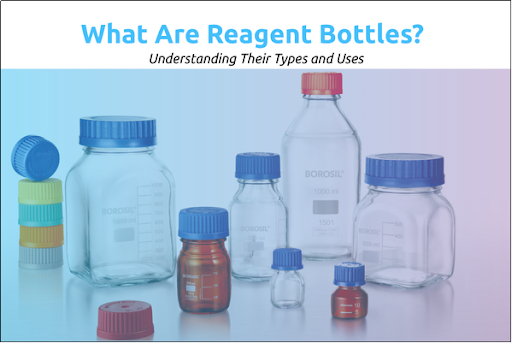



In laboratories, reagents are used all the time, which makes their upkeep important. A reagent bottle plays a crucial role in storing and handling chemicals and sensitive solutions. These bottles preserve the quality of reagents and prevent contamination, spills or leaks.
Choosing the right bottle based on a chemical’s properties is vital for maintaining accuracy and safety in experiments.
A reagent bottle is designed to store chemicals, whether in liquid or solid form. It is made of heavy-walled 3.3 borosilicate glass, which withstands temperature variations and resists chemical reactions better than regular glass.
These bottles may have narrow mouths to minimise evaporation, or wide-mouth to facilitate the transfer of powders or granulated substances. Some bottles feature volume marking, helping you estimate volumes quickly. If you’re storing light-sensitive substances, you can choose an amber bottle.
Borosil Scientific offers a range of reagent bottles that cater to different lab requirements. These cover standard lab needs, whether you’re storing a photo-sensitive liquid or general reagents.
Reagent bottles must withstand exposure to strong chemicals. Borosilicate glass is known for its resistance to thermal shock and chemical attack, so it remains a go-to option for labs that store volatile or reactive substances.
It’s wise to read a chemical compatibility chart before using any container. If you’re storing something like concentrated sulphuric acid, a well-tested borosilicate glass bottle, such as Reagent Bottles 1501 from Borosil Scientific, reduces the chance of contamination.
A secure sealing mechanism is crucial to prevent leaks, which can lead to accidents or compromise prepared solutions. Screw caps come in various materials, often polypropylene or phenolic resin, and they form a tight seal on the bottle. This system is user-friendly. You just twist the cap off, pour, twist it back on.
Glass stoppers offer another sealing style. They’re often ground to fit precisely into the neck, creating a snug seal. This is popular for chemicals that must remain stable in long-term storage. The Borosil Scientific 1500 line, for instance, has an internal glass stopper that keeps moisture and contaminants out.
Some compounds degrade when exposed to UV or visible light, making light protection essential. That’s where amber bottles step in. Amber reagent bottles help by filtering out harmful wavelengths, preserving the stability of sensitive solutions. If you’re storing silver nitrate or certain dyes, consider the Reagent Bottles 1519 or 1509 from Borosil Scientific. Both are amber and protect your reagents without any complicated add-ons.
Lab workflows sometimes require heating or cooling your reagent bottles. Maybe you autoclave the bottle to sterilise it or place it in a cold room for extended periods, borosilicate glass ensures stability. It resists cracks from sudden temperature changes, which is a relief when you’re juggling multiple tasks in a busy lab.
A glass reagent bottle from a reliable brand helps you avoid shattered containers chemical spills or spoilage.
Laboratories also try to save money and eliminate waste. A heavy-duty glass reagent bottle can be cleaned, sterilised, and reused many times. It may seem like a tiny thing, but over months or years, you can save lots of money by recycling glassware. If you’re storing the same reagent long-term, glass reagent bottles are cost-effective.
Reagents must remain pure from storage to usage, as even minor contamination can affect experimental results. High-quality reagent bottles help prevent external pollutants through features like narrow mouths, secure seals, and durable materials.
Reagent bottles should integrate smoothly into various lab workflows, whether transferring solutions to an HPLC machine or preparing titrations. Features like clear markings, sturdy handles, and a stable base enhance convenience and efficiency.
Some labs also prefer consistent bottle shapes because it helps them organise shelves or automated dispensing lines. The design of Reagent Bottles 1501 or 1509 often suits these setups.
Lab safety rules exist to protect you and those around you. Choosing the right container for each reagent is essential. Flammable solvents may require specially approved bottles, while corrosive acids and bases must be stored in containers designed to withstand their reactivity.
Amber glass also helps with compliance. Some regulations state that light-sensitive substances must be in dark or amber containers. Following these guidelines keeps your lab in line with audits and industry norms.
Reagent bottles are central to many lab tasks. They store stock solutions, buffer solutions, or media for microbiological studies. They also hold leftover chemicals after large-scale syntheses, so you can revisit them later for additional tests or replications.
In academic labs, you’ll see them lined up during practical sessions. Students often use them for standard solutions in titration experiments. In pharma or biotech, these bottles house precious materials, like active ingredients that must stay stable over months.
Environmental testing labs also rely on them to store water or soil extracts for contaminant analysis. Some labs even use them to keep reference standards for spectroscopic tests. When the right reagent bottle is in the right lab, everything runs more smoothly.
A reliable reagent bottle might seem like a minor detail, but it keeps your work accurate and your lab environment safe. It stores chemicals in a secure, controlled way. You can rest easy knowing your solutions won’t degrade or contaminate your entire bench. At Borosil Scientific, we offer a range of options – amber glass for light-sensitive materials, screw-cap designs for quick access, and glass stoppers for airtight storage.
No one wants a lab accident or questionable data. Having the right container ensures your chemicals stay safe and your team can focus on what truly matters – advancing science efficiently and reliably.